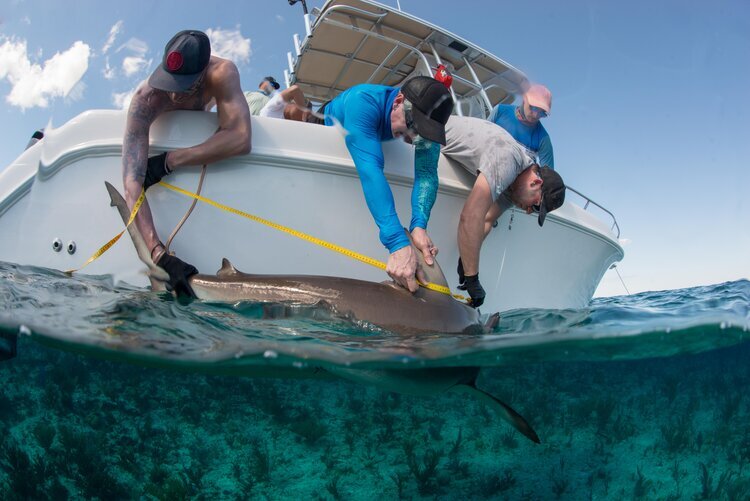Sharks of ANDROS
Understanding the distribution patterns, resource use and ecological role of sharks
LOCATION: Andros Island, The Bahamas
Overview
Sharks are among the most morphologically and physiologically diverse taxonomic group in our oceans, leading to vast differences in distribution patterns, resource use, and ecological roles. Tiger sharks and hammerheads serve as top predators across coral reefs and seagrass beds, while nurse sharks are demersal, living on the benthos and predominantly feeding on molluscs and crustaceans. Among the most important questions for the future is how will changes in the environment affect species differently, and consequently change the structure of marine communities. Andros is home to more than 10 species of sharks that frequently use its waters, however we have a very limited understanding of the habitats they use, the prey they feed on, and the interactions they have with other shark species through predator-prey and competitive relationships. As such, understanding how each shark species utilizes the resources in Andros’ waters is important as we predict the consequences of changing water temperatures and shifts in food web structure.
Conservation Concern
Many sharks are threatened by overfishing, fisheries bycatch, and habitat deterioration across much of their range, however the Bahamas are a shark sanctuary. Thus, Andros and the other Bahamian islands support some of the healthiest tropical and subtropical shark populations in the world. As such, they serve as a template from which to understand shark population and community dynamics in more natural conditions, which can be compared to areas where human impacts are pervasive to identify key areas for improvement. Yet, Bahamian sharks are not without concern – habitat deterioration and prey reduction through fisheries are among the most widespread human actions that threaten all marine ecosystems. Species like lemon sharks and sawfish heavily rely on mangrove forests as nursery and feeding grounds, while the fish that reef sharks feed on rely upon healthy coral colonies, and require certain population sizes for spawning and refuge. Despite the recognition that our actions damage many marine habitats and their associated communities, coastal development, overfishing, and other destructive actions increase the vulnerability of all species, including sharks, necessitating an understanding of essential habitat and prey communities to ensure the maintenance of species and their functions within ecosystems.
Research Questions
Do changes in habitat characteristics across Andros seascapes lead to spatial variability in shark communities and food web interactions?
Do sharks exhibit preferential habitat use patterns in Andros? Which species are found in all habitats and which use specific habitats?
Which shark species are seasonal residents, and migrate between Andros and other Caribbean islands? Which species are year-long residents of Andros?
Which shark species compete for similar food resources in Andros? Which species exhibit the most generalized diets and which are most specialized?
Are juveniles and adults of all each shark species found in Andros? Do juvenile sharks use different resources than adults due to risk of predation?
Donate and support shark research
Dr. Guttridge leading length measurements on a bull shark caught via a drumline in a shallow coral reef habitat.
Trip leader Dr. Keller drawing blood from a Caribbean reef shark to learn more about its role within the food web.
A large adult nurse shark is temporarily restrained alongside our research vessel for tagging, measurement and sampling.




